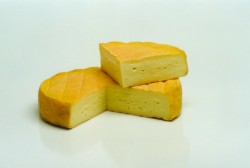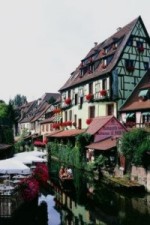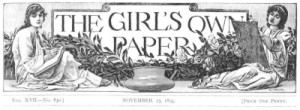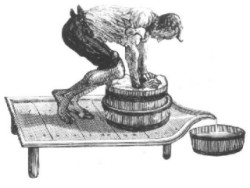
Issue No. 5 - February/March 1999 |
|
|
 |
|
Welcome to the 5th issue of the Teddington Cheese
Wire. Our third Christmas was very hard work but most enjoyable. Thank
you to those who visited The Teddington Cheese for being so patient
and jovial in the queues over the Festive Season. Many thanks also to
all those who ordered their cheese in advance.
|
|

|
Our mail order service has been growing steadily throughout
the year and was popular over Christmas. It gives us real pleasure to
think of our cheeses being savoured throughout Britain. We hope those
who received cheeses and hampers as gifts enjoyed them.
|
|
In addition to our regular cheeses we also have a
'Cheese of the Week'. We choose a special new cheese each week which
enables both customers and ourselves to try some of the many thousands
of cheeses which we would otherwise never get a chance to sample. When
calling into the shop or placing an order by phone or via the internet,
why not ask about the cheese of the week?
Above:
A brother washing his cheese. Monks have been accomplished cheese-makers
for centuries.
|
|
|
 |
|
|

- Cheese focus -
MUNSTER
Alsace, France
Munster originates from the upper Munster valley
in the Vosges mountains of Alsace, France. Munster is an ancient
cheese. It has been in existence since the Middle Ages and was originally
made in monasteries. The name Munster comes from the town of that
name which is itself a contraction of the word 'monastery'. Benedictine
monks, Irish monks who settled in the Vosges in the 7th century,
observing their order's rule against meat, sought nourishment in
milk and its derivatives. Although it was first made for their own
consumption, the monks later taught the local peasants how to make
Munster cheese. The local people then used their cheeses to help
pay rent to the monks whose land they farmed. The success of the
cheese led to it being produced over a wide area and brought a little
prosperity into a harsh and deprived region.
|
|

Photo: A typical town of Alsace with timber
framed buildings and geranium filled window boxes.
|
Our Munster comes from one of only a few farms
still producing the cheese. These are found along the top of the
Vosges and to the west of the small town of Munster. Milk from the
Vosgienne cow is used. The cows were originally imported from Scandinavia
during the 18th century. They graze in the valleys and the mountain
pastures called Chaumes, from which the popular Chaumes cheese is
named. Most Munster available today is made in factories using pasteurised
cows' milk. Our Munster, however, is the original farm produced version
made with unpasteurised cows' milk. Pasteurisation destroys the perfume
of the flowers of the high chaumes on which the cattle graze.
|
|
Maturation takes place at a temperature of 12-14ºC.
This takes 4 to 6 weeks for small thin cheeses and 2 to 3 months
for thicker larger cheeses. Farm Munsters are first matured for a
week outdoors before being transferred into caves, They then sit
on rye straw next to older Munsters from which they acquire the rind
flora. Every other day the cheeses are washed and brushed with brine
and annatto. The paste is soft and creamy and has a shiny brick red
rind. As with all the washed rind cheeses, Munster has a strong,
penetrating smell develops a tangy taste when fully mature.
Our cheeses are approximately 150mm in diameter,
30mm thick, 500g in weight and have a fat content of 45-50%. The
best seasons are summer and autumn and the very best cheeses are
made with milk from the 'high stubble' of the Vosges.
The wine to accompany Munster is the local Gewurztraminer
or full-bodied and full- bouquet red wines or even a beer - the region
is close to the beer loving nation, Germany. Munster is often eaten
with baked potatoes and finely chopped onions. Munster flavoured
with caraway seeds is also to be found but purists believe it should
be enjoyed without.
A cheese called Géromé is made on the other side
of the Vosges mountains in Lorraine. Munster gained its A.O.C. in
1969 and in 1978 the A.O.C. Munster-Géromé united these two cheeses.
|
|
|
- Cheese Tips -
THE BEST PLACES TO STORE YOUR CHEESE
The question we are most often asked is, "Where is the
best place to store cheese?" Here are some tips in response to this:
All cheeses prefer a damp and cool environment. However,
if it is too cold the cheese loses its flavour and its development suffers.
If it is too warm the cheese sweats, quickly grows mouldy and may over-ripen.
If it is too damp the cheese will quickly grow mouldy and if it is too
dry the cheese will dry and crack. Favourable places for storing cheese
are listed below:
1. Cellar or larder:
These are the best places but, unfortunately, few houses are blessed with
them.
2. Shed or garage:
Generally good places but they are susceptible to weather changes. They
may become too hot in the summer and too cold in the winter.
3. Refrigerator:
In the majority of centrally-heated houses the refrigerator is simply the
safest place to keep cheese. Use the warmest part of the fridge - this
is the top shelf unless there is an old-fashioned ice box at the top, in
which case the salad drawer at the bottom is best.
Wherever you keep your cheese ensure that it remains
wrapped in the waxed paper in which we sell it. If storing in a cellar,
shed or garage then cover the cheese in a damp tea-towel and place inside
a vermin-proof box. Only use cling film if a refrigerator is being used.
Always allow cheese to stand at room temperature for a couple of hours
before enjoying.
|
ARE YOU GOING TO A
PARTY?
Why not leave the bottle at home
and offer to take cheese instead? Whether served as a separate course
at a dinner party or a snack at a house party the cheese never gets
left on the side with all the unopened bottles. We can put a selection
together and send it to you anywhere in the UK, even at short notice.
It needn't cost much more than a bottle of good wine.
|
|
BACK
TO TOP
|
|

The threat of foreign imports.
Does British cheese face a gloomy future?
In an article written for 'The Girls Own Paper' of November 1885,
the writer's chief concern was that British cheese was being threatened
by foreign imports.
At first one would imagine that the threat came from
over the Channel from France, Holland, Italy etc., but this was not
the case. The cheeses from Europe were already well respected and a
part of British life. The threat was from further afield, from America
and also from New Zealand. The author writes:
"It is a sad state of things that such excellent cheese as Cheshire
and Gloucester should be driven out of the market by the very inferior
kind sent over from America. We do not regret the disappearance of English
cream cheeses, because the manufacture of that class of cheese has never
been understood in this country, and if an article is not good we care
not whether it is of British or Foreign manufacture, it ought to be
withdrawn from the market to make way for what is better, but that our
own excellent home-produced cheeses should disappear is outrageous.
The Americans have treated us badly in the matter. They can and do make
excellent cheese, but having secured the English market, they think
they can palm off upon us any rubbish they like. If however they do
not repent and mend their ways a Nemesis is in store for them, as the
samples sent over from New Zealand are better and cheaper and seem to
point to New Zealand as the coming foreign producer for the English
market."
Today, American cheese is scarce in Britain, except
for a small number of factory cheeses. It is ironic, however, that America
has quite recently tried to ban the worldwide production of unpasteurised
cheese which would have eradicated the majority of British farmhouse
cheeses. Cheeses from New Zealand have always been made on a large scale
and produced more for profit than pleasure. There is a small amount
of farmhouse production which is barely sufficient for its home market
and we are unlikely to see it here in the UK for quite some time. Moreover,
the majority of farmhouse cheeses found in both countries are interpretations
of British and European cheeses so there seems little point in importing
them when you can buy the original items here.
During the last 100 years the major threat to British
cheese has not been from foreign imports but from other influences.
During the war years the milk production was commandeered to make Government
Cheddar in the large creameries, with the task of providing protein
for the nation. After the war cheese production simply did not re-establish
itself on the farms. It has only been in the last twenty years that
the profile of British farmhouse cheese has been raised and it is for
the moment recovering.
In our next issue of the Cheese Wire, over 100 years
on, we take a look at the world of British cheese today and ask if the
recovery will continue or if it does still face a gloomy future.
** Many thanks to the customer who kindly provided
the article from 'The Girls Own Paper'. It has been a fascinating read
for us all.
BACK
TO TOP
|
|
|
|
- RECIPE -
Monastery leeks
serve as a starter for four
Ingredients
Munster cheese (150g)
dry white wine (2 tbsp)
1 egg yolk
double cream (2 tbsp)
leeks (700g) cut into 2cm lengths
butter (25g)
plain flour (25g)
milk (220ml)
salt
1. Remove the rind from
the cheese and divide in two.
2. Put one half in the fridge
to chill and mash the second with the wine, egg yolk and cream.
3. Simmer the leeks for
7 to 10 minutes in salted water.
4. Meanwhile, melt the butter,
add the flour and stir for 2 minutes. Gradually blend in the milk
until it boils and thickens. Then stir in the cheese mixture.
5. Drain the leeks, pour
over the Munster sauce and then grate the chilled Munster over the
top.
6. Bake in the oven at 160ºC/325º
F/Gas 3 for 10 minutes.
|
|
|
- Tools of the trade -
The Cheese Press
In issue 2 of the Teddington Cheese Wire we described
how cheese is made with milk being soured, renneted and then cut
with knives to produce curds and whey. Almost all cheeses start out
this way but the processes which follow dramatically affect the final
cheese.
|

Above: A mechanical cheese press as used
by Cheshire cheese-makers. |
Cheeses such as cottage cheese, cream cheese and
curd cheese are made by draining away a proportion of whey, and in
some instances applying a light pressure. This leaves a moist cheese
which must be eaten fresh. It can only be kept for a few days.
To make soft cheeses such as Brie and Camembert
the curds and whey are scooped into moulds and the whey drains away
through small holes. The cheese is never pressed. Further drying
occurs as the cheeses are ripened. These cheeses can last from a
couple of weeks to a number of months.
|
|
Many cheeses such as Cheddar, Cheshire
and Lancashire are made by draining off as much whey as possible,
by gravity, leaving only the moist curds. These curds are then put
into moulds and pressure is applied. The pressure forces out even
more whey. The resulting cheese can be matured for many months and
in some cases many years. The type of cheese being made dictates
the amount of pressure applied and over what period.

Above: A manual
cheese press
Many different designs of press exist.
The earliest versions were made of wood and later ones of iron. In
factory production the presses are hydraulically powered. In farmhouses
the presses rely on the good old reliable force of gravity and time
and many are still in use today.
|
|
|
| BACK TO TOP |
|
|
| All
articles © www.teddingtoncheese.co.uk
|
|








